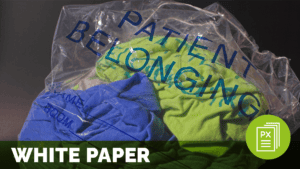Providing Comfort and Communication to Enhance the ‘Wait Experience’

Waiting in a healthcare setting, specifically an Emergency Department (ED), is arguably one of the most uncomfortable places to wait. The patient is in distress, physically and mentally.
According to real-time survey results from patients discharged from the ED, length of wait time and lack of communications top the list of main concerns. In 2018-19, it was reported the average ED wait time in Canada was three to four hours, and Lakeridge Health was no exception. Though we are unable to change the length of the wait, we can change the experience of the wait.
To better understand these experiences and to consider improvements, we mobilized a group of Lakeridge Health’s Patient and Family Experience Advisors and staff to co-design a solution.
One key member of the group, Hasina Reshamwalla, joined the Advisor program after several ED visits with an interest in co-designing improvements. Hasina offered insights and ideas to enhance the wait experience.
Hasina shared that, “As Advisors, we all come from different backgrounds, which allows for a creative perspective of what is truly needed in the ED.”
Through the co-design process, the group determined a volunteer role in the ED waiting areas was needed. This role could support and enhance communication through tasks that may include ensuring a patient hears their name being called when it is their turn, helping with transportation needs, such as waiting with patients for their ride after discharge, and communicating with family members unable to enter the department due to COVID-19 restrictions.
Providing comfort items and actions was also identified as an important support need. Comfort items and actions may include a warm blanket, ice chips, or diversional activities (including toys for children of any age), assisting patients with charging a personal device, or guiding them to a phone to make a call.
Volunteers were ideal to perform this role, as they provide a kind-hearted and compassionate presence and could be the liaison for the hospital team. As this article notes, volunteers subconsciously demonstrate to patients that the hospital truly cares about them. What’s more, the volunteer role is done on an individual’s own time, reflecting positively on the rest of the hospital staff.
Lakeridge Health Volunteer Resource Specialist Sharon Hudson-Alipanopoulos schedules and orients volunteers to the ED role. She notes that “volunteers are vital in the ED. Patients tend to view the volunteer’s motive as purely altruistic. It’s a kind person when you need a friendly face, and someone who can help navigate the wait in the ED…positively impacting the patient’s experience.”
Volunteers were asked to share feedback about their shifts. They told us they felt safe when performing their role and the top tasks were answering patient and family members’ questions at the entrance and listening for the patient’s name, followed closely by providing comfort items and actions.
Hasina shares a time when she de-escalated a family with communication and comfort measures.
“A young patient arrived via ambulance after a car accident and was taken directly to trauma,” she said. “His parents arrived shortly after and were frantic. The staff tried to calm them, but the parents were scared and wanted answers. As a mother, I understood their fears and expressed this to the parents. I let them know staff were working hard to help their son, and I would keep them updated. I offered the mother a warm blanket and the father a glass of water. They immediately became less frantic.”
Co-designing and implementing the ED volunteer role to provide comfort and communication to waiting patients has proven to be highly effective in enhancing patient experiences.
For more information, please contact Lina Reid, Patient Experience Consultant, Lakeridge Health at lireid@lh.ca.
Author Bios:

Lina Reid has been a manager in both Long-Term Care and Acute care for 18 years. In her current role as Patient Experience Consultant, she uses her cumulative skills to support the Patient and Family Experience Advisor program and to enhance patient experiences.

Sharon Hudson-Alipanopoulos has 25 years experience in the certified profession of Volunteer Management. She has managed hundreds of volunteers and was recently awarded the National ‘Exemplary Leader Award’ 2021 in recognition of her contributions to the field as a mentor, leader, trainer, and advocate.

Hasina Reshamwalla is a retired Mediator and spends her free time volunteering as a Patient and Family Experience Advisor and collaborating with professionals to enhance the patient experience. Hasina, a cancer survivor and pacemaker recipient, has battled near death encounters while facing the challenges of being a single mother and of Southeast Asian decent.
Related content
-
 Environment & Hospitality | Policy & Measurement | Quality & Clinical Excellence
Environment & Hospitality | Policy & Measurement | Quality & Clinical ExcellencePX Chat – Restfulness of Hospital Environment
12pm ET / 11am CT / 10am MT / 9am PT – Join The Beryl Institute community for an engaging PX Chat as we explore the 2025 updates to the HCAHPS survey, with a special focus on the new “Restfulness of Hospital Environment” measure. Breakout discussion groups will provide the opportunity for community members to
Learn more -
 Environment & Hospitality | Patient Family & Community Engagement
Environment & Hospitality | Patient Family & Community EngagementWhere Are My Things? Best Practices for Safeguarding Patient Belongings in Hospitals
Managing patient belongings is a persistent and complex challenge faced by nearly all hospitals and healthcare systems. When personal items are misplaced or lost during a patient’s hospital stay, the consequences go beyond inconvenience. Financially, hospitals may be liable for compensation or replacement of lost items, and operational resources are often diverted to investigate and
Learn more -
 Environment & Hospitality | Patient Family & Community Engagement
Environment & Hospitality | Patient Family & Community EngagementReimagining the Non-Clinical Patient and Family Environment
So much of healthcare journeys focus on precise treatment protocol to address a medical issue, and clinical experiences are oftentimes the only area of interest. But what happens when you prioritize non-clinical experiences within a hospital setting? This is what St. Jude Children’s Research Hospital set out to do when developing Family Commons, a new
Learn more
